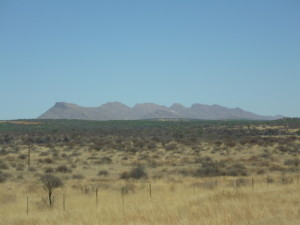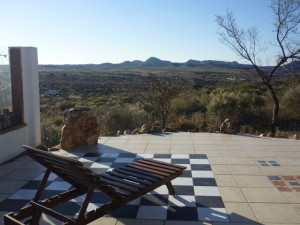After being in the Kalahari Desert for over two weeks, the landscape finally changed. It felt dramatic to my eyes, because I had been staring out at monotonously flat land, where one could see far into the horizon, for weeks. Now, suddenly, the flat was interrupted and little mounds began to dot the horizon. At first they were small and infrequent, but as we neared Windhoek, Namibia, the rocky, rugged mountains (now reminiscent of Utah or Nevada) became larger, more pronounced, and more frequent, as if to announce our impending arrival into a place of great importance. A welcome fit only for a capital city.
 I’ve wanted to go to Namibia for a number of years now. No – I wasn’t one of those Namibia-fans as a result of Angelina’s public childbirth here. My Namibia-desire hit me like a smack in the face after I saw pictures of the Namib Desert merging into the cold Atlantic Ocean, and the resulting eerie fog.
I’ve wanted to go to Namibia for a number of years now. No – I wasn’t one of those Namibia-fans as a result of Angelina’s public childbirth here. My Namibia-desire hit me like a smack in the face after I saw pictures of the Namib Desert merging into the cold Atlantic Ocean, and the resulting eerie fog.As I crossed into the Namibian border from Botswana, I reflected on this long-time desire. And I realized that, besides my image of golden sans hitting blue crashing ocean waves, I knew nothing of Namibia!
And so I researched. And it turns out that Namibia has a long, confusing, and oft-bloody history similar to most Southern African countries. The various African tribes fought for centuries over the best land, best cattle, most power, and most prestige. The battle for land continued into the 19thcentury, when the South Africans, the British, and the Germans entered the scene. These colonial powers fought one another as well as the tribes, and it was the Germans that emerged victorious (ironically enough, this was only a few years after the then-chancellor announced that he had no interest in participating in the “Scramble for Africa”).
The Germans left Namibia (then German South West Africa) during WWI, only 30 years after officially declaring it a colony. At this point, the country was entrusted to South Africa by the League of Nations. They sneakily proceeded to try to transform the country into a province of their union, and it wasn’t until the late 1980s that the international community – with the help of tribal guerillas (SWAPO) based out of the newly independent Angola – managed to oust South Africa from Namibia.
In 1989, the newly independent Namibia held its first democratic elections, to an impressive 97% voter turnout! SWAPO leader Sam Nujoma was elected, and the West proudly watched as a democratic constitution was created. Pride, however, transformed into concern as Nujoma befriended Zimbabwe president Robert Mugabe, and hailed him for his “successful” land reform policies. Even more distressing to the West was when Nujoma changed his 10-year old constitution to allow himself an extra term as president. Thankfully, he stepped down in 2004 for his chosen SWAPO successor, Hifikepunye Pohambo.
Namibia’s stability and democratic procedures continue to impress the West and serve as a role model for the rest of Africa. Yet, despite its apparent success, statistics like a GDP of USD $5500 mask grave social inequalities that still exist as a result of the old colonial and apartheid policies. Over 50% of Namibians live on only $2/day, while the white population control the majority of farm land (and thus, wealth). In Windhoek, this division is pronounced, as the whites generally live in the lovely eastern suburb of Klein Windhoek, while the poor blacks and coloreds live in the crowded township of Katutura, all the way at the other end of town.
 With this newfound knowledge in mind, Bruno and I crossed through the arid rocky mountains trumpeting our arrival into Windhoek. I hadn’t been in a proper city in three weeks, since I left Johannesburg to meet Bruno in Botswana. This wasn’t by happenstance. Bruno isn’t a fan of cities – he finds them stressful, overcrowded, and unnerving. Since I was here to get to know Bruno and his lifestyle, we had contented ourselves with camping on farms, near rivers, and on deserted salt pans in the middle of the Kalahari.
With this newfound knowledge in mind, Bruno and I crossed through the arid rocky mountains trumpeting our arrival into Windhoek. I hadn’t been in a proper city in three weeks, since I left Johannesburg to meet Bruno in Botswana. This wasn’t by happenstance. Bruno isn’t a fan of cities – he finds them stressful, overcrowded, and unnerving. Since I was here to get to know Bruno and his lifestyle, we had contented ourselves with camping on farms, near rivers, and on deserted salt pans in the middle of the Kalahari.Filled with the anticipation of seeing a new city (which, unlike Bruno, I enjoy), we entered Windhoek. After a full day of errands – groceries at Super Spar (not just the regular one!), browsing at the largest shopping center in all of Namibia, and visits to a few airline offices, I was utterly wiped. As the heat and the stress of the city mounted, I found myself longing for the tranquility of the chirping birds, rustling rivers, and whistling winds. Beautiful, calming, natural sounds. Strangely, after only three weeks in the bush, I felt like Crocodile Dundee entering New York City! Certainly not the reaction to Windhoek that I was expecting – especially since it has a density of a mere 2 people per square kilometer!
I plan on visiting Windhoek again. But for now, I have retreated to a campsite 15km north of the city to lick my wounds on a farm, with a river, and tons of chirping birds. Ahhhhh…..



Anonymous - This is a beautiful piece of writing B, Amanda had tears in her eyes as I read it to her. It is close to the true essence of you I think 🙂 {{Love}} Richard